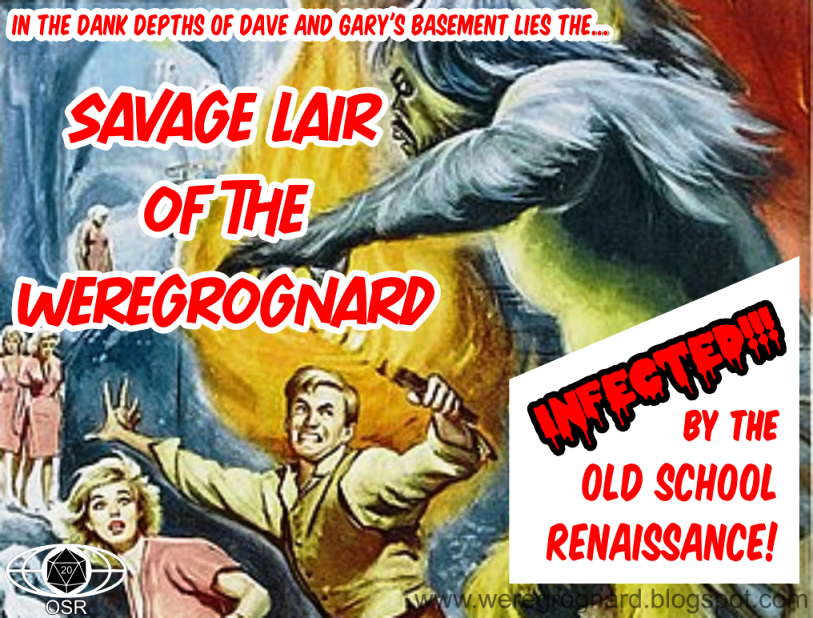Area B: The Fungal Jungles
 |
This map is released under terms of the CC BY-SA 4.0 license. |
This region of the Underwilds is covered in myconic foliage and large-to-gigantic, fungal “trees” of various species. These thrive on the moisture originating from the shores of the Sea of Darkness (Area D.) Much of said foliage glows with bioluminescence, and the area’s predators have adapted similar, glowing patterns in their outer covering to better hide in their surroundings (3-in-6 surprise.) The eunshiel deep fey that call these jungles home also wear bioluminescent camouflage, processed from local mushrooms, for a similar effect.
 |
| The glowing beauty of the Jungles conceals many dangers (AI image courtesy of NightCafe.) |
B1: Rev-G Tunnels
This cavern has several small deposits of a lodestone-like mineral. Up ahead, light sources may cause player characters (PCs) to notice something glittering in the 60-ft. high ceiling. They won’t have much time to ponder or inspect the phenomenon as a high concentration of the strange mineral in a10-foot area causes gravity to reverse suddenly. The first PCs entering this area will fall upward into the ceiling-turned-floor and smash violently for 6d6 damage (no save.)
Any surviving characters will find that the glittering comes from dead humanoids' belongings, particularly treasure: coins (10,000 sp and 2,000 gp) and five gems (100 gp x3, 500 gp, 1,000 gp.)
PCs returning to this hex have a 2-in-6 chance of encountering another reverse gravity area. However, there is no treasure in these instances, but other remains and some mundane goods may exist.
The gravity-reversing mineral is a component that can be used in the construction of a girdle of levitation, flying or a similar device from an Elder Builder diagram (see Level 7, D5.)
B2: Pods of Dissolution
A raised, hill-like area is studded with tall, fungal “trees” that have a few strange, glowing pods hanging under the caps. Under the pods, the hill is covered in a thicket of mushrooms. This area is the lair and hunting ground of a flock of three (3) disopterans – fleshy-winged humanoids with large, milky eyes and corrugated mouth/chin areas.
When prey passes under the pods, they unfurl to reveal the winged creatures, which glide silently and with extraordinary speed towards their victims. The disopterans grapple and envelop their prey in their wings, then secrete an acid from their buccal corrugations. The disopteran then feeds by lapping up the dissolving, organic sludge with an extendable proboscis, leaving bones and inorganic matter intact. Any leftover sludge promotes fungal growth which covers the victim’s remains.
Disopterans: AC 3 [17]; HD 6 (HP 28, 32, 28); MV 10 ft. (3 ft.,) flight 150 ft. (40 ft.); ATK special or 1d6 (proboscis); SV fighter 6; ML 9; AL C
Feeding: on a successful hit, the disopteran wraps a human-sized or smaller victim with its wings. On the following and subsequent rounds, it regurgitates acid that causes 1d4 damage plus the victim’s descending Armor Class (AC.) For example, a victim wearing leather suffers 1d4+7 damage, while one wearing plate suffers 1d4+3. Shields offer no protection, and do not count towards the AC total.
Proboscis: a disopteran can attack anyone disturbing its feeding process by whipping its sharp, bone-tipped proboscis, which causes 1d6 damage.
Vulnerable Victims: area attacks and spells deal half damage to the disopteran and half to its victim.
Screech: Disopterans emit an unnerving sound that acts as form of echolocation. Character within 60 feet must save against spells or suffer a random effect for 1d4 rounds (roll 1d6): 1-3 – dizziness and nausea results in a -2 to hit rolls, 3-5 – fear (as the spell), 6 – paralysis (as a hold spell;) regardless of save and effects, the exposed characters become immune to the sound for 24 hours.
The remains hidden under the mushroom-carpeted floor include treasure: 3,000 cp, four gems (10gp, 100gp x2, and 1,000 gp,) and two pieces of jewelry (600 gp and 1000 gp.) A carved, soapstone statuette shaped like an eagle is a figurine of wondrous power. On command, the figure turns into a small roc for six (6) hours. It acts as a trained creature of the same type and follows the owner’s commands. When its time is up, the soapstone roc reverts to a figurine and cannot be summoned again for five (5) days. It also reverts if brought to zero (0) hit points.
B3: Hunters’ Traps
This area is a hunting ground for eunshiel from a nearby village (see B4 below.) PCs crossing this hex have a 2-in-6 chance of falling into a 100-foot deep, lava tube pit covered in carefully-grown, tall mushrooms to conceal its existence. 50% of random encounters in this area will be with a hunting party of 2d10 eunshiel in bioluminescent camouflage (3-in-6 surprise.)
 |
| Eunshiel hunters (AI image courtesy of Bing Image Creator.) |
B4: Clan Indralas Village
An eunshiel village belonging to Clan Indralas blends seamlessly into the surreal environment of the Jungles here. It consists of a series of interconnected platforms, walkways, and bridges, all perched high above in immense, old-growth mushroom caps. The ancient, fungal "trees" emit an eerie, ethereal glow, which casts a pale, otherworldly light across the village. Houses and structures inside and atop the mushrooms are also crafted from fungi native to the Underwilds and sculpted into elaborate forms, that give the village a mystical, organic appearance.
 |
| An eunshiel fungus village (AI image courtesy of NightCafe.) |
The village of 130 eunshiel has a force of 26 warriors ready to defend their home with poisoned blades and ennan-crafted crossbows. The force is led by four (4) Dragonsworn commanders with 5+1 HD and spells as 5th-level elves. The commanders' duties are split between patrols, village defense, and guarding the green dragon lair (see below.) Patrols of 2d4 eunshiel (including its Dragonsworn commander) range the 24-mile area (1-2 hexes) around the village and wear bioluminescent camouflage to blend into the environment (3-in-6-surprise.) Any random encounters in this area are with such a patrol.
On the tallest mushroom is a shrine to Tiama’at and the home of the village’s leader, a shamanic priestess named Zar’thra (10 HD, 42 HP, spells as cleric or druid, if using Advanced options.)
 |
| Zar’thra the Fungal Shaman (adapted from AI images courtesy of NightCafe.) |
Beyond the village is an immense, fungal bulb studded with tunnels and suspended on stalactites. It is the lair of mated green dragons (HP 42, 41) and their remaining brood of two, younger dragons who will soon seek their own lairs (HP 39, 29.) The dragons’ treasure hoard is divided and scattered among the bulb's inner tunnels. It consists of ancient coins (98,000 sp and 30,000 ep,) as well as an array of ennan and eunshiel-crafted jewelry pieces and other precious objects (500gp x2, 600 gp x2, 800 gp x4, 900 gp x4, 1100 gp x3, 1200 gp x3, 1400 gp, 1500 gp x2, 1600 gp x3, and 1700 gp x2)
B5: Most Excellent Prismatic Chimes
PCs entering this hex begin to hear the occasional, chime-like sound (*ding*) followed by similar, periodic sounds (*doon*…*ding*…*dong*…) Following these sounds to their source reveals a pond surrounded by large, multicolored crystals. When drops of water from the cavern ceiling fall on these crystals, they glow briefly and make the chiming sounds. The scene is quite beautiful to behold and listen to.
Unfortunately, this area is also a watering hole and hunting ground for creatures of the area. Random encounters here have a 3-in-6 chance of occurring.
B6: Two Worms, One Cave
PCs entering this hex will be forewarned by subtle tremors that grow more intense as they reach a rare sight which occurs only once every century or so. Two (2) purple worms (HP 68, 77) have encountered each other and are in the process of mating. Their undulating bodies writhe and thrash about the fungal growths, covering them in glowing spores. Disturbing this beautiful act of colossal, annelid love may have deadly consequences.
B7: Gathering of the Mushroom Men
A valley surrounded by a crown of stalagmites has a fairy ring-like circle of 19 mushrooms 2-8 feet tall surrounding a tall, 11-ft. mushroom with a wide cap. Characters who observe this area for a turn or more will notice the circle of mushrooms is actually circumambulating, albeit at a very slow pace. These are members of a village of sentient mushroom people that have evolved to live peacefully while avoiding most predators and Chaotic creatures of the Jungles. This village "council" is discussing, via their unique language of vibrations that exude spore clouds, how much time they have to move on due to an ennan fungus-logging operation that has been spotted nearby.
Communicating with the mushroom-men may be next to impossible without magic for speaking with plants, as they do not speak or understand vocal languages. However, on a positive reaction, they will collectively exude hallucinatory spores that will show the PCs visions of their plight. On a negative reaction, the mushroom-men will use their spore abilities for defense in the hopes that it will drive the intruders away.
Mushroom-Men: AC 9 [10]; HD 1-4 (Leader 5); MV 90 ft. (30 ft.); ATK spores; SV magic-user 1-5; ML 8 (Leader 9); AL N
Spores: Mushroom-men are non-violent. However, each can exude a cloud of spores in a radius equal to their HD x 10 feet in self-defense. Victims must save against poison or suffer a spell-like effect (roll 2d4+HD):
3: Poisonous spores kill as a reversed, raise dead spell. They also function as an animate dead spell on dead bodies. This is a form of reproduction, as new mushroom men grow on the corpse.
4: Strong, hallucinogenic spores function as a confusion spell
5-6: Spores cause hallucinations that cause fear
7-9: Spores induce a groovy state of euphoria and charms the victim to be friendly with the mushroom men (and ward away enemies.)
10-11: As 5-6 above
12: As 4 above
13: As 3 above
The ennan loggers’ camp is 1d4 hexes away in a random hex direction (roll 1d6.) There are 17 loggers total with a 7 HD leader. If the PCs slay, drive away, or otherwise convince the loggers to leave, they will be welcome to rest in th emushroom men's "village" at any time. They will have access to water, edible (non-sentient) fungus, and have relative safety from random encounters (-1 to roll.)
This work includes material taken from the System Reference Document 5.1 (“SRD 5.1”) by Wizards of the Coast LLC and available at https://dnd.wizards.com/resources/systems-reference-document. The SRD 5.1 is licensed under the Creative Commons Attribution 4.0 International License available at https://creativecommons.org/licenses/by/4.0/legalcode.

























